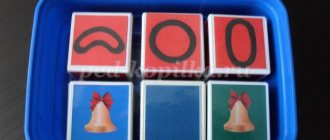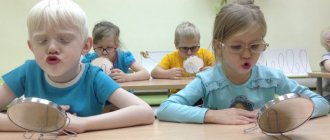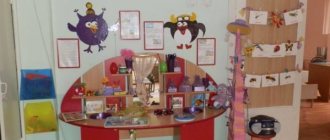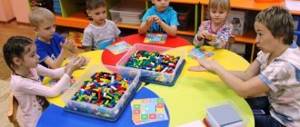In recent years, there has been an increase in the number of children with various speech defects. All this encourages the preschool educational system to find and implement the most productive teaching methods for this category of children. An integrated approach using traditional and non-traditional techniques increases cognitive activity. The introduction of ICT tools increases the efficiency of speech therapy work in general.
The use of gaming technologies in preschool educational institutions makes it possible to create the most optimal conditions for the correctional and educational process with children with speech impairments. Visualization of the main components of oral speech activates the work of the motor, auditory and visual analyzer. The Federal State Program states that the result of implementing the requirements of the curriculum should be the creation of a comfortable, developing educational environment.
The leading principles of the Federal State Educational Standard in the work of a speech therapist teacher
- Creation of a progressive developmental educational environment;
- Introduction of educational interactive complexes for comfortable learning.
Good and coherent speech is an essential condition for the comprehensive development of preschool children. It allows you to express your thoughts, build communication connections and realize your creative potential. The most productive means of speech correction are gaming technologies. They contribute to the harmonious formation of the child’s mental processes and intellectual capabilities.
Gaming technologies in the work of a speech therapist
- Multimedia presentations. Interactive complexes with a correctional and speech therapy focus combine dynamics, sound and images, which allows the child to complete practical tasks independently or together with a teacher. At the same time, the use of ICT tools helps to retain the baby’s attention and facilitate the process of perceiving and remembering information with the help of vivid images;
- Flash games. The software supplied with the interactive equipment helps you create your own gaming exercises for specific purposes. In computer game tasks, you can use products of children’s creative activity - plasticine figures, collages, drawings. The introduction of personally significant elements into classes will increase their interest;
- Competitions, quizzes, competitions. In this case, it is necessary to create a friendly atmosphere in the team so that the children support each other and there is a feeling of unity in each group. Children are very easily involved in the learning process, which takes place in a playful way, and small competitions between teams develop mental operations and help improve speech and mental processes.
Modern gaming technologies in preschool educational institutions make it possible to create the most favorable conditions for the development of preschool children. Game activities using the interactive Schooner and Castle complexes activate children's knowledge, stimulate speech activity and, as a result, form a positive attitude towards learning. The included teaching materials, a table for sand therapy, a carpet grapher, and mirrors for individual work allow you to effectively model a correctional and developmental program for preschoolers.
Modern methods, innovative technologies in the correctional and developmental work of a speech therapist at a preschool educational institution
Alena Vasilievna Lidzhieva
Modern methods, innovative technologies in the correctional and developmental work of a speech therapist at a preschool educational institution
Municipal state preschool institution
Kindergarten No. 28 “Sar-Gerel”
Modern methods , innovative technologies in the correctional and developmental work of a preschool teacher-speech therapist .
Teacher speech therapist
Lidzhieva Alena Vasilievna
Elista
2015
Slide No. 2
Modern methods , innovative technologies are introduced , new, highly effective methods and techniques that are the end result of the intellectual activity of the teacher himself.
We have to note that the number of children with various speech disorders is increasing from year to year. And there is no point in talking about the importance of speech therapy work in kindergarten . Clear, literate, and correct speech of a preschooler is undoubtedly the key to successful schooling. In the modern world, in correctional work with children , it is no longer enough to use traditional technologies .
Slide No. 3
So, the main criteria for the need to introduce innovative technologies are
• increasing the efficiency of the educational process through its application;
• achieving the maximum possible success as soon as possible;
• optimization of the correction ;
• creation of a rich, healthy, harmonious and educational space for full and general development.
During class, a child draws, sculpts or reads, answers questions, but this work does not affect his thoughts and does not arouse interest. He is passive. Of course, he learns something, but passive perception and assimilation cannot be the basis of solid knowledge. The child most fully and clearly perceives and remembers what was interesting to him. To interest children and make learning meaningful, we need non-standard approaches, individual development programs, and new innovative technologies .
Slide No. 4
Today, innovative impact technologies are known:
1. Art therapeutic technologies .
2. Modern technologies of sensory education.
3. Modern technologies of speech therapy and finger massage.
4. Cryotherapy, body-oriented techniques .
5. Information technology .
6. Su-Jok therapy.
Studying in detail the latest in methodological literature , for myself, in my professional activities, I decided to use innovative methods , which in my opinion are most suitable in correctional work with children diagnosed with ODD (general speech underdevelopment, mental retardation, ADHD (hyperactivity syndrome) and lack of attention)
visiting our group.
Let's look at some of them.
Slide No. 5
The first method : the use of computer tools that relate to information technology - allows you to increase the interest and motivation of children in classes, ensure an imperceptible transition for the child from gaming activities to educational ones, makes it possible to expand the plot content of traditional gaming activities, as well as the ability to quickly create your own didactic material , and due to increased emotional tone, a faster transfer of the studied material into long-term memory is carried out.
To achieve positive results, I successfully use computer games, interactive DVD films and cartoons, training games, and thematic presentations for children.
Slide No. 6
The following method belongs to the body-oriented technique . method is the movement of the hands with the movements of the organs of the articulatory apparatus. When performing an articulation exercise, the hand shows where and in what position the tongue, lower jaw and lips are located. Such gymnastics helps to maintain the child’s interest for a long time, helps to increase the motivational readiness of children, and maintains a positive emotional mood of the child and the teacher throughout the entire lesson.
Slide No. 7
From art therapeutic technologies, I use the mnemonic method - this is a system of techniques that facilitate memorization and increase memory capacity by forming additional associations. The essence of mnemonic diagrams is as follows: for each word or small phrase, a picture (image, symbol)
. Thus, the entire text is sketched schematically. Looking at these diagrams - drawings, the child easily reproduces textual information.
Slide No. 8
From body-oriented techniques : Chromotherapy is a science that studies the properties of light and color. The goal of this therapy is to normalize muscle tone and neutralize negative conditions. Relaxation exercises based on chromotherapy - promote relaxation, introspection, and recollection of positive events and sensations - some colors caress the eye, soothe, promote a surge of internal strength, invigorate, while others can irritate or even depress.
Slide No. 9
• The next method , also related to art therapeutic technologies : music therapy is a method of psychotherapy based on the emotional perception of music.
In my classes I use the following music therapy techniques:
- listening to various musical works;
- singing special speech therapy phrases to musical accompaniment.
Slide No. 10
Collage is a technique in fine art that involves gluing materials that differ in color and texture onto any base.
In speech therapy, this technique can be considered one of the methods of not only cognitive, but also speech activity. In the process of working on collages, children master the ability to coherently convey content, master dialogical speech, and learn to combine images and objects with each other in size, color, and spatial arrangement.
Slide No. 11
And one more series of art therapeutic technologies , which include creative play therapy.
For example: games with colored lids. With the help of this visual material, I introduce children to the concepts of primary colors, comparison of quantities, and develop fine motor skills and the ability to think logically. I play various games that I include in classes.
Slide No. 12
Croupotherapy and sand therapy are methods of sensory therapy , the purpose of which is to develop motivation for speech communication, improve visual-spatial orientation, stabilize the emotional state, develop creative abilities, and correct various aspects of speech.
Slide No. 13
Games with cereals are an excellent and exciting type of games with children that promote the development of fine motor skills of the fingers.
What cereals are suitable for games?
It’s better to start with semolina - this cereal is clean, small, and if a child takes it in his mouth, then nothing bad will happen (it’s difficult to choke or put it in his nose or ears)
. Then you can switch to playing with corn grits and continue using beans, rice, and buckwheat.
My children and I play in “dry pools”
- these are containers, about 9-10 liters each, which are filled with different types of cereals. I invite the child to put his hands in it, together with him I move the cereal with my hands, picking it up in one fist, then in the other. This is how we begin to get acquainted with cereals, teach them to distinguish them by shape, size and touch, and play various games in class.
In more detail, I will dwell on the technique - sand therapy . So - in my opinion, it is the most appropriate and effective in correctional work with children 4 - 5 years old .
Slide No. 14
Playing with sand is an excellent mediator for establishing contact with a child. And if the child still speaks poorly and cannot tell an adult about his experiences, then playing with sand everything becomes possible. By acting out an exciting situation with the help of small figures, creating a picture out of sand, the child is freed from tension and anxiety.
Playing with sand solves many problems, and most importantly, it develops communication skills, i.e. the ability to communicate normally.
Slide No. 15
All games using sand are divided into three areas:
1. Educational games - aimed at developing tactile-kinesthetic sensitivity and fine motor skills of the hands. And most importantly, the child talks about his feelings, thereby spontaneously developing his speech, vocabulary, developing the perception of different tempos of speech, developing the pitch and strength of his voice, working on breathing , developing attention and memory, and developing phonemic hearing. Learning to read and write goes on unnoticed.
2. Educational games, with their help we help to understand the diversity of our world.
3. Projective games, with their help we carry out psychological diagnostics, correction and speech development .
Slide No. 16
Using sand therapy in classes undoubtedly gives positive results:
• among children studying in our group, interest in speech therapy classes has increased significantly;
• children feel more successful;
• there is no place for monotony and boredom in classes.
Slide No. 17
In my opinion, the use of games, be it sand, cereals, some pebbles, shells, sticks, in general, various natural materials, especially in our group for children with severe speech impairments, is a very effective tool in educational and correctional work .
work in close contact with parents, who reinforce the skills and abilities acquired by children in classes at home. I try to interest parents and actively include them in the educational process of the group. I would like to find helpers and allies in my parents.
Thus, we can conclude that the use of new forms of work helps to organize classes more interesting and varied, turn boring work into lively and creative work, maintain children’s interest throughout the entire training, and also ensure speed of memorization, understanding, and assimilation of program material in full. volume.
But we must remember that modern , innovative technologies are not good in themselves, but only as an addition to generally accepted, time-tested technologies ( diagnostic technology , sound production technology , technology , etc.)
Slide No. 19
Thank you very much for your attention!
Advantages of using interactive complexes
- Allows you to maintain the child’s attention at all stages of the curriculum;
- Help reduce the time required to correct speech skills;
- Promote the fastest elimination of speech defects;
- Increase the efficiency of speech therapy work, reduce children’s fatigue;
- They allow you to make the training program quite simple and productive.
Teachers and educators note that through gaming technologies it is much easier for a speech therapist to solve educational, correctional and educational problems. Modern interactive devices promote the development of grammatical structure of speech, expand and activate vocabulary, improve mental processes, and help cultivate initiative and responsibility.
The use of ICT tools in speech therapy classes will improve the teacher’s effectiveness and help intensify pedagogical processes.
Innovative technologies in speech therapy within the framework of the Federal State Educational Standard
Experience as a speech therapist. Innovative technologies in speech therapy practice
Being on the border of contact between pedagogy, psychology and medicine, speech therapy uses in its practice, adapting to its needs, the most effective, non-traditional methods and techniques of related sciences, which help optimize the work of the teacher - speech therapist.
Innovative technologies in speech therapy practice are only an addition to generally accepted, time-tested technologies (diagnostic technology, sound production technology, technology for the formation of speech breathing for various disorders of the pronunciation side of speech), these are: - new and more effective methods and tools, techniques that are the ultimate the result of the teacher’s intellectual activity; — new ways of interaction between teacher and child; - new stimuli that serve to create a favorable emotional background, promoting the inclusion of intact mental functions in work and the activation of impaired mental functions. In relation to the pedagogical process, innovation means the introduction of new things into the goals, content, methods and forms of education, the organization of joint activities of the teacher and the child. The main criterion for the “innovativeness” of a technology is to increase the efficiency of the educational process through its application. INNOVATIVE TECHNOLOGIES IN Speech Therapy: • art - therapeutic technologies; • modern technologies of speech therapy and finger massage; • modern technologies of sensory education; • body-oriented techniques; • “Su-Jok” – therapy; • cryotherapy; • information Technology. Types of art therapy: • music therapy (vocal therapy, playing musical instruments); • iso-therapy (non-traditional drawing techniques); • kinesiotherapy (dance therapy, body-oriented therapy, logorhythmics, psycho-gymnastics); • fairytale therapy; • puppetry; • mnemonics; • creative play therapy (sand therapy); • laughter therapy; • aromatherapy; • color therapy (chromotherapy). “Art therapy” is a means of free self-expression. In a special symbolic form: through a drawing, a game, a fairy tale, music - we can help a person give vent to his strong emotions, experiences, and gain new experience in resolving conflict situations. The main goal of art therapy is to develop a person’s self-expression and self-knowledge through creativity and to increase his adaptive abilities. The goals of art therapy in working with children are to promote the formation of high vitality and harmonious relationships with the outside world, the development of mutual understanding between children, as well as between children and adults. Teach your child self-expression, the ability to manage their feelings, experiences, emotions. Music therapy is a method of psychotherapy based on the emotional perception of music. Depending on the melody, its rhythmic basis and execution, music can have a wide variety of effects. Corrective tasks of music therapy: • normalization of neurodynamic processes of the cerebral cortex, normalization of biorhythm; • stimulation of auditory perception (activation of right hemisphere functions); • improvement of the general condition of children; • improving the quality of movements (expressiveness, rhythm, and smoothness develop); • correction and development of sensations, perceptions, ideas; • stimulation of speech function; • normalization of the prosodic side of speech (timbre, tempo, rhythm, expressiveness of intonation); • formation of word formation skills; • formation of the syllabic structure of a word. Elements of music therapy During a relaxing speech therapy massage, pieces that have a sedative effect are used, and during an active massage, pieces that have a tonic effect are used. It is also possible to use tonic pieces of music during dynamic pauses and articulatory gymnastics. Isotherapy techniques used for speech development: • “blotography” technique; • finger painting; • drawing with soft paper; • poke painting with a hard semi-dry brush; • drawing on glass; • nitcography; • drawing on semolina; • technique of drawing with leaves, sticks, pebbles, etc.; • cotton wool imprinting technique; • “cork impression” technique; • drawing with palms. Body-oriented techniques: All childhood experiences are associated with the development and improvement of voluntary movements (dressing, eating, walking, playing, and, of course, speaking). By paying attention to the development of the child’s motor sphere, we indirectly influence the development of mental properties. A child’s ability to control his bodily manifestations affects the development of his character, abilities and, of course, speech. • bioenergoplasty – combining the movements of the articulatory apparatus with the movements of the hand; • stretching – alternating tension and relaxation in different parts of the body, normalizes muscle hypertonicity and hypotonicity; • relaxation exercises – promote relaxation, introspection, recollection of events and sensations and are a single process; • breathing exercises – improve the rhythm of the body, develop self-control and volition. Kinesiological exercises are a set of movements that allow you to activate interhemispheric interaction: • develop the corpus callosum, • increase resistance to stress, • improve mental activity, • help improve memory and attention, • facilitate the process of reading and writing, • improve both the mood and well-being of the person performing them person. Exercises such as “Fist - rib - palm”, “Bunny - ring - chain”, “House - hedgehog - castle”, “Bunny - goat - fork”, etc. Speech therapy massage Speech therapy massage is one of the speech therapy technologies, an active method of mechanical effects aimed at correcting various speech disorders. The goal of speech therapy massage is not only to strengthen or relax articulatory muscles, but also to stimulate muscle sensations, which contributes to the clarity of kinesthetic perception. The kinesthetic feeling accompanies the work of all muscles. Thus, completely different muscle sensations arise in the oral cavity depending on the degree of muscle tension during the movement of the tongue and lips. The directions of these movements and various articulatory patterns when pronouncing certain sounds are felt. Massage of the muscles of the peripheral speech apparatus helps to normalize muscle tone and thereby prepare the muscles to perform complex movements necessary for the articulation of sounds. Performing speech therapy massage techniques requires a clear diagnosis of the state of muscle tone not only of the muscles involved in articulation, but also of the muscles of the face and neck. The main types of speech therapy massage include: • classic manual; • point; • hardware. Finger massage • massage of palm surfaces with stone, metal or glass multi-colored balls; • pin massage; • massage with nuts and chestnuts; • massage with hexagonal pencils; • massage with rosary; • massage with herbal bags; • stone massage; • massage with probes, probe substitutes; • massage with Su-Jok therapy devices. Logorhythmics is a system of musical-motor, speech-motor and musical-speech games and exercises carried out for the purpose of speech therapy correction. Cryotherapy is one of the modern non-traditional methods of correctional pedagogy, which consists in the use of games with ice. The dosed effect of cold on the nerve endings of the fingers has beneficial properties. Fairytale therapy is a method that uses the fairy tale form for speech development of the individual, expansion of consciousness and improvement of interaction through speech with the outside world. The main principle of fairy tale therapy is the holistic development of the individual, caring for the soul. Corrective tasks of fairy tale therapy: • creating a communicative orientation of each word and statement of the child; • improvement of lexical and grammatical means of the language; • improving the sound aspect of speech; • development of dialogic and monologue speech; • effectiveness of playful motivation for children's speech; • relationship between visual, auditory and motor analyzers; Elements of fairy tale therapy: • cooperation of the speech therapist with children and with each other; • creating a favorable psychological atmosphere in the classroom, enriching the child’s emotional and sensory sphere; • introducing children to the past and present of Russian culture and folklore. Puppet therapy is a section of art therapy that uses a doll as the main method of psychocorrective influence, as an intermediate object of interaction between a child and an adult. The goal of puppet therapy is to help smooth out experiences, strengthen mental health, improve social adaptation, increase self-awareness, and resolve conflict situations in collective activities. Mnemonics is a system of techniques that facilitate memorization and increase memory capacity by forming additional associations. Mnemonics helps in the development of: • coherent speech; • associative thinking; • visual and auditory memory; • visual and auditory attention; • imagination; • accelerating the process of automation and differentiation of delivered sounds. The essence of mnemonic schemes is as follows: for each word or small phrase, a picture (image) is created. Thus, the entire text is sketched schematically. Looking at these diagrams - drawings, the child easily reproduces textual information. Sand therapy is a therapy method that promotes better speech correction and the development of the emotional-volitional sphere. Sand therapy promotes: • improving practical communication skills using verbal and non-verbal means; • enrichment of vocabulary; • development of coherent speech; • encouraging children to take active action and concentrate attention; • development of imagination and imaginative thinking. Laughter therapy is a type of psychotherapy that helps to remove blocks, relax, and get rid of shyness. Humor and laughter lift your spirits, help establish communication connections, and allow you to effectively cope with stressful situations. Aromatherapy is the use of essential oils and oil suspensions to improve human health. Smells control mood, calm an overexcited nervous system, and increase performance. Children are sensitive and impressionable people who perceive the effects of aromatherapy without any prejudice, so their reaction to essential oils is always positive. The use of aromatherapy will help maintain a good mood in children, and also help cure colds and sleep disorders. Children love warm, sweet smells most. However, due to the fact that their body is still in a state of development, aromatherapy products should be used for them in very minimal dosages. It is best if the oils are applied to terracotta and clay figurines, aroma medallions, and pillows. Various products made from untreated wood, orange or grapefruit peels hold odors well. Types of aromatherapy: • baths; • spraying; • inhalation; • massage. Color therapy (Chromotherapy) – restoration of individual biological rhythm using specially selected color. The period of preschool childhood is also a period of intensive sensory development of the child. Stimulating the intellectual and emotional development of preschool children with color therapeutic agents is justified and effective. Working with color helps solve many problems: • increases the level of communication of children and their emotional responsiveness; • enriches the sensory and emotional experience of children; • introduces you to techniques for managing your feelings, and develops self-control skills. Children, even the smallest ones, are naturally programmed to have a certain reaction to a particular color. The mood, behavior and even state of health are influenced not only by the color of the surrounding space, but also by the color of the clothes the child is wearing. The presence of any color in a child’s life (for example, red) can invigorate and improve mood, while at the same time its excess can cause a state of overexcitation and increased motor activity. Color therapy undoubtedly contributes to: • improving the psychological microclimate in the children's team; • stimulation of the intellectual and emotional development of preschool children; • children's acquisition of psychophysical relaxation skills. Color therapy is indispensable when used in children's institutions. Educational information technology is a pedagogical technology that uses special methods, software and hardware (cinema, audio and video, computers, telecommunication networks) to work with information. Possibilities of using IT in speech therapy: • increasing motivation for speech therapy classes; • organizing objective monitoring of children's development and activities; • expansion of the plot content of traditional gaming activities; • the ability to quickly create your own didactic material; • visualization of acoustic components of speech; • expansion of the range of non-verbal tasks; • provide an unnoticeable transition for the child from play activities to learning activities; • significant opportunities in the development of HMF: schematization, symbolization of thinking; formation of the planning function of thinking and speech; • due to increased emotional tone, the material being studied is transferred more quickly into long-term memory. To interest children and make learning meaningful, we need non-standard approaches, individual development programs, and new innovative technologies. It is important to preserve both traditional approaches and develop new directions in speech therapy theory and practice, and also to remember that any innovation is not good in itself (“innovation for the sake of innovation,” but as a means, a method that serves a specific purpose. In this regard, it is very important stages of its development and dissemination, which precisely show the need and effectiveness of the new technology. Innovative methods of influence in the work of a speech therapist are becoming a promising means of correctional and developmental work with children with speech disorders. These methods are among the effective means of correction and help achieve the maximum possible success in overcoming speech difficulties in preschool children.Against the background of comprehensive speech therapy assistance, innovative methods, without requiring much effort, optimize the process of correcting children's speech and contribute to the improvement of the whole body.
We recommend watching:
Speech therapy constructor Difficulties in teaching reading to children with severe speech impairments Summary of educational activities in the compensatory preparatory group for children with severe speech impairments
Summary of educational activities in the older group of children with severe speech impairments on the topic: “Sound K”
Similar articles:
Summary of a speech therapy session with primary school children diagnosed with ODD
Summary of GCD for children of the senior speech therapy group
Summary of a speech therapy session with children 5-6 years old with mental retardation
Design of a speech therapy room for preschoolers
Summary of educational activities in the older group of children with severe speech impairments on the topic: “Sounds S - Z”






